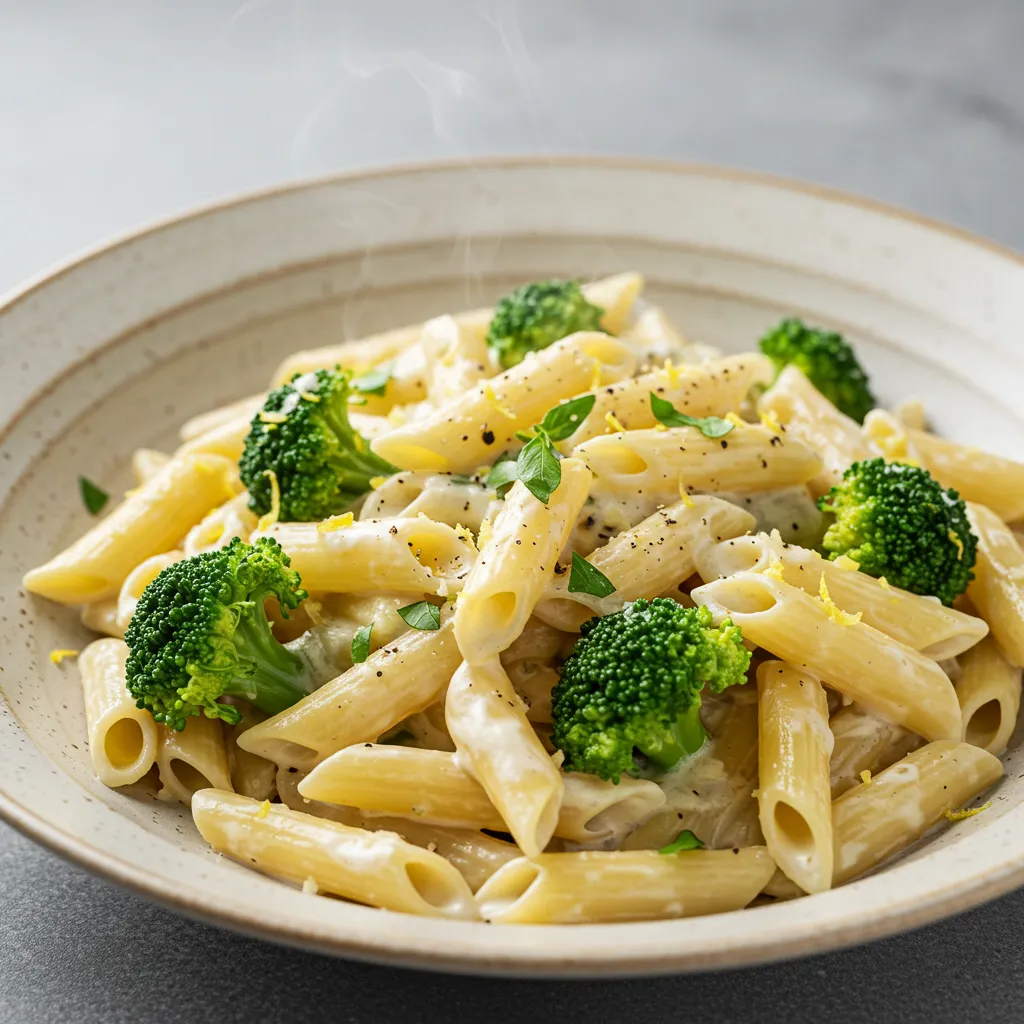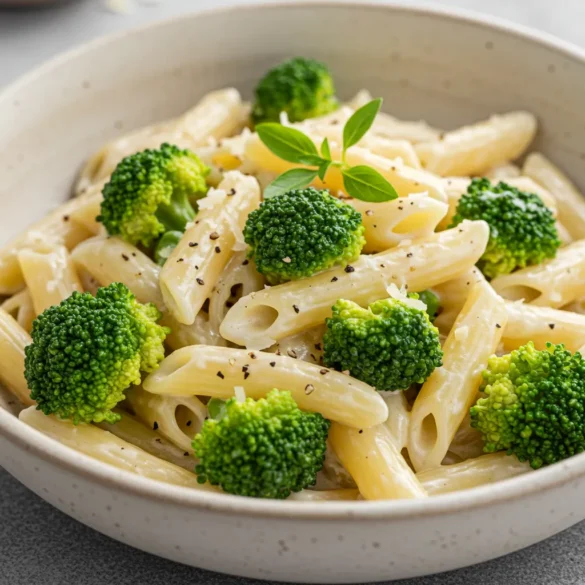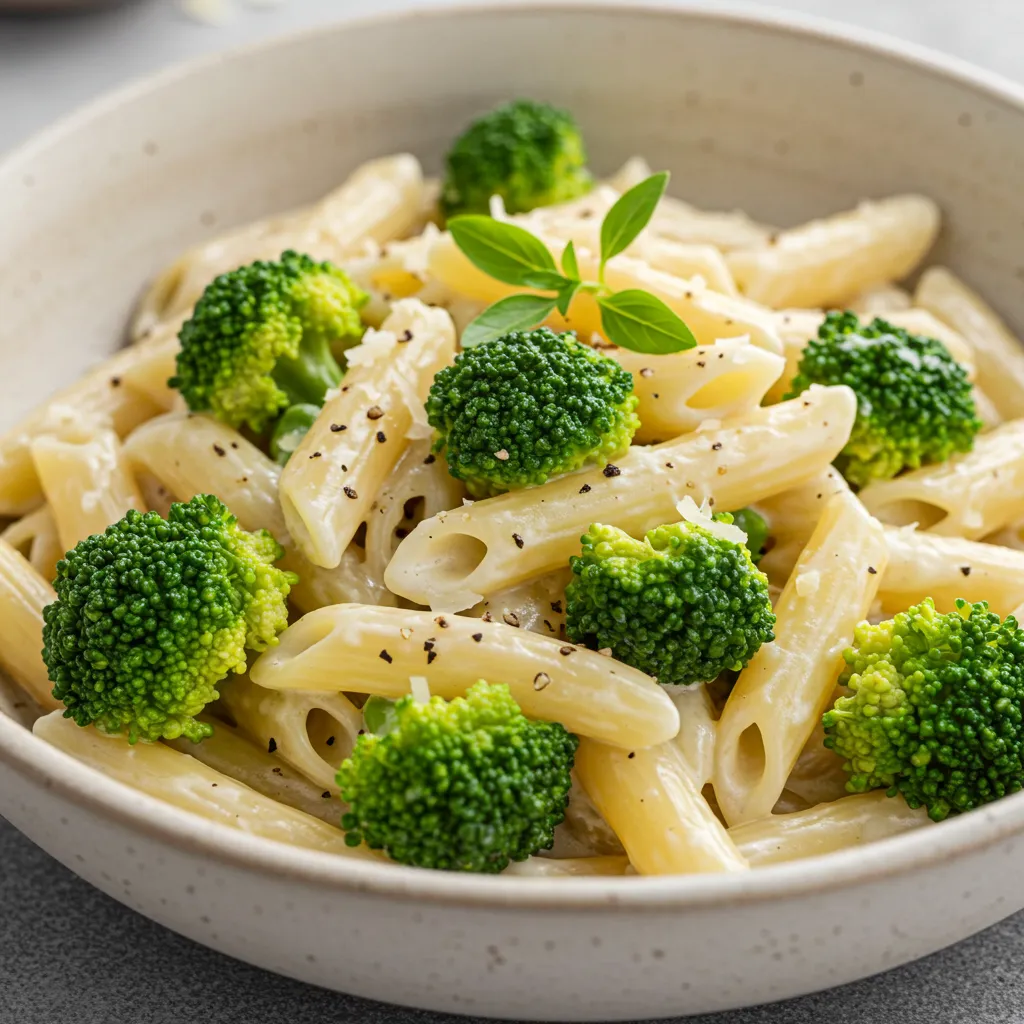This luxurious Creamy Pasta with Broccoli transforms simple ingredients into an impressive dish that rivals any restaurant version. Al dente pasta and tender-crisp broccoli florets are enveloped in a silky, garlicky cream sauce that’s perfectly balanced—never greasy or heavy like many restaurant versions. Ready in just 30 minutes, this elegant yet comforting meal delivers restaurant-quality flavors with the freshness and satisfaction that only homemade cooking can provide.
Why You’ll Love This Recipe
- The sauce achieves velvety perfection without being overly rich or heavy
- Customizable pasta shape allows you to make it your own family favorite
- Bright green broccoli adds nutrition and visual appeal to the creamy backdrop
- Comes together faster than ordering takeout, yet tastes like a special occasion meal
- Leftovers reheat beautifully for a quick next-day lunch
Ingredients
For the Pasta and Broccoli
Pasta – Creates the substantial, satisfying base for the dish, with ridged varieties best for holding the sauce
Fresh broccoli – Provides essential nutrients, beautiful color, and pleasant texture contrast to the creamy elements
Olive oil – Used for briefly sautéing garlic, adding a subtle fruity undertone to the dish
Garlic – Forms the aromatic foundation that elevates the entire sauce with its depth of flavor
Salt – Enhances all flavors and properly seasons the pasta water for the best texture and taste
For the Creamy Sauce
Butter – Creates richness and helps form the base for a silky-smooth sauce
Heavy cream – Provides luxurious body and mouthfeel that distinguishes homemade from commercial versions
Parmesan cheese – Contributes savory depth, slight saltiness, and helps thicken the sauce naturally
Black pepper – Adds subtle heat and complexity that balances the richness of the cream
Nutmeg – A traditional addition that provides barely perceptible warmth and complexity
Optional Garnishes
Fresh herbs – Brighten the dish with color and fresh flavor that cuts through the richness
Red pepper flakes – Add a pleasant heat that contrasts with the creamy sauce
Lemon zest – Provides a citrus brightness that elevates the entire dish
Additional grated Parmesan – Enhances the cheesy flavor and creates an appealing finish
Step-by-Step Instructions
Preparing the Ingredients
Begin by bringing a large pot of generously salted water to a rolling boil. While waiting for the water to boil, wash and cut the broccoli into even-sized florets, about 1-1.5 inches in size. This uniformity ensures the broccoli cooks evenly. Peel and mince the garlic cloves, grate the Parmesan cheese if not using pre-grated, and measure out the remaining ingredients so they’re ready when needed. Having everything prepared before you start cooking ensures a smooth process and prevents the sauce from overcooking while you’re measuring ingredients.
Cooking the Pasta and Broccoli
Once the water reaches a full boil, add the pasta and cook according to package directions for al dente texture, typically 8-10 minutes depending on the shape. During the last 3 minutes of the pasta’s cooking time, add the broccoli florets to the same pot. This efficient method not only saves using an extra pot but allows the broccoli to become tender-crisp without losing its vibrant green color. Before draining, reserve one cup of the starchy pasta water to use later for adjusting the sauce consistency. Drain the pasta and broccoli together in a colander, but do not rinse, as the starch on the pasta helps the sauce adhere better.
Creating the Creamy Sauce
Return the empty pasta pot to the stove over medium-low heat. Add the olive oil and butter, allowing the butter to melt completely. Add the minced garlic and sauté for just 30-60 seconds until fragrant but not browned, as browned garlic can become bitter. Pour in the heavy cream and bring to a gentle simmer, being careful not to let it boil vigorously. Simmer for about 2-3 minutes until the cream begins to reduce slightly. Gradually sprinkle in the grated Parmesan cheese while continuously whisking to prevent clumping. Continue to cook the sauce for another 2-3 minutes until it thickens enough to coat the back of a spoon. Season with salt, freshly ground black pepper, and a small pinch of nutmeg, adjusting to taste.
Combining and Finishing the Dish
Add the drained pasta and broccoli back to the pot with the sauce, gently tossing to coat every piece with the creamy goodness. If the sauce seems too thick, add a splash of the reserved pasta water, a little at a time, until you reach your desired consistency. The starch in the pasta water helps maintain the silky texture of the sauce. Allow the pasta to sit in the sauce for a minute to absorb some of the flavors. Taste and adjust seasonings if necessary. Serve immediately in warmed bowls, garnished with additional freshly grated Parmesan, a sprinkle of fresh herbs, red pepper flakes if desired, and a light grating of lemon zest to brighten the rich flavors.

Pro Tips
- Use freshly grated Parmesan from a block for the smoothest sauce texture and best flavor
- Salt your pasta water until it tastes “like the sea” for properly seasoned pasta
- Don’t overcook the broccoli—it should remain bright green and slightly crisp
- Warm your serving bowls in the oven for a few minutes to keep the pasta hot longer
- If using dried herbs instead of fresh, add them to the sauce earlier to release their flavors
Storage Tips
This Creamy Pasta with Broccoli is best enjoyed immediately after preparation when the sauce is at its silkiest and the pasta has the perfect texture. However, leftovers can be stored in an airtight container in the refrigerator for up to 3 days. The sauce will thicken considerably when chilled due to the cheese and cream content. To reheat, place the pasta in a saucepan over low heat and add a splash of milk or cream to loosen the sauce. Gently warm while stirring frequently until heated through, being careful not to let it boil, which can cause the sauce to separate. Alternatively, you can reheat in the microwave at 50% power in short intervals, stirring between each until just heated through. A sprinkle of freshly grated Parmesan and a few drops of water or cream before reheating can help revive the dish. Due to the cream-based sauce, this dish is not recommended for freezing, as the dairy components tend to separate and become grainy upon thawing, and the broccoli may become overly soft.
Customization Ideas
This versatile Creamy Pasta with Broccoli can be adapted in numerous ways to suit different tastes and dietary needs. For a protein boost, add grilled chicken breast, sautéed shrimp, or crispy bacon bits. Vegetarians might enjoy the addition of sun-dried tomatoes, toasted pine nuts, or sautéed mushrooms for extra umami flavor. To make the dish lighter, substitute half-and-half for the heavy cream and increase the amount of pasta water to maintain creaminess. For those following a gluten-free diet, simply swap in your favorite gluten-free pasta. Spice lovers can increase the red pepper flakes or add a dash of cayenne for heat. A Mediterranean twist could include Kalamata olives, artichoke hearts, and feta cheese in place of some of the Parmesan. For a seasonal spring variation, add fresh asparagus or peas along with the broccoli. Those who prefer a stronger cheese flavor might mix in some sharp cheddar, Gruyère, or even a little crumbled gorgonzola. Whole wheat or legume-based pasta can boost the nutrition profile while adding a nutty flavor dimension. For a vegan version, use plant-based butter, cashew cream, and nutritional yeast in place of the dairy components.
Special Technique: Creating the Perfect Silky Sauce
The hallmark of truly exceptional Creamy Pasta with Broccoli lies in achieving a sauce with the perfect silky consistency—rich enough to coat each strand of pasta but light enough to avoid the leaden heaviness found in lesser versions. The key technique involves the strategic use of pasta cooking water, which contains dissolved starch that acts as a natural thickener and emulsifier. After creating your initial cream and cheese mixture, the incorporation of this starchy water helps bind the fats with the water-based elements, preventing the dreaded separation that can occur in dairy-based sauces. For optimal results, add the pasta water in small increments, about 2 tablespoons at a time, while continuously stirring or tossing the pasta. The motion creates friction that helps the sauce cling to the pasta while the heat activates the starch. Another critical factor is temperature control—the sauce should never reach a full boil after the cheese has been added, as high heat can cause the proteins in the cheese to seize and create a grainy texture. Instead, maintain a gentle heat just below simmering. Finally, the choice of cooking vessel matters; a heavy-bottomed pan distributes heat evenly and reduces the risk of scorching, while finishing the pasta in the sauce rather than simply pouring sauce over cooked pasta allows the starch, sauce, and pasta to truly become integrated, creating that restaurant-quality union of flavors and textures that makes this dish truly special.
Common Questions
Can I use frozen broccoli instead of fresh?
Yes, frozen broccoli can be used in a pinch. Thaw it first and add it to the pasta during the last minute of cooking since it’s already blanched. Pat it dry before adding to prevent excess water in the sauce.
Why did my sauce turn out grainy?
This typically happens when cheese is added to too-hot liquid or when the sauce boils after adding cheese. To fix this, keep the heat low when adding cheese and whisk continuously.
What pasta shapes work best with this sauce?
Shapes that capture sauce in their ridges or curves work beautifully—try fettuccine, penne, farfalle, or orecchiette. Avoid very small pasta like orzo or angel hair which can get lost in the sauce.
How can I make this dish ahead for a dinner party?
Cook the pasta slightly less than al dente and make the sauce separately. Refrigerate both, then reheat the sauce gently, add a splash of cream, combine with the pasta and broccoli, and finish cooking together just before serving.
Is there a way to make this healthier without sacrificing creaminess?
Replace half the cream with evaporated skim milk and increase the amount of pasta water. The starch in the pasta water adds creaminess without the fat, while a good quality Parmesan maintains flavor.

Ingredients
- 12 oz (340g) pasta of choice (fettuccine, penne, or fusilli work well)
- 4 cups fresh broccoli florets (about 2 medium heads)
- 2 tablespoons olive oil
- 2 tablespoons butter
- 4 cloves garlic, minced
- 1½ cups heavy cream
- 1 cup freshly grated Parmesan cheese, plus more for serving
- ½ teaspoon salt, plus more for pasta water
- ¼ teaspoon freshly ground black pepper
- Pinch of ground nutmeg
- Optional garnishes: chopped fresh parsley or basil, red pepper flakes, lemon zest
Instructions
- Bring a large pot of water to a boil. Add 1 tablespoon of salt to the water once it's boiling. This properly seasons the pasta and broccoli from the inside out as they cook.
- Add the pasta to the boiling water and cook according to package directions until almost al dente, typically 8-10 minutes depending on the variety.
- When the pasta has about 3 minutes left to cook, add the broccoli florets to the same pot. This timing ensures the broccoli becomes tender-crisp without overcooking.
- Before draining, carefully reserve 1 cup of the starchy pasta water in a heat-safe measuring cup or bowl. You'll use this later to adjust the sauce consistency.
- Drain the pasta and broccoli together in a colander, but do not rinse. The starch on the surface helps the sauce adhere better to the pasta.
- Return the empty pot to the stove over medium-low heat. Add the olive oil and butter, allowing the butter to melt completely.
- Add the minced garlic to the pot and sauté for 30-60 seconds until fragrant but not browned, as browned garlic can develop bitter notes.
- Pour in the heavy cream and bring to a gentle simmer, being careful not to let it boil vigorously which can cause it to reduce too quickly or even separate.
- Gradually sprinkle in the grated Parmesan cheese while continuously whisking to ensure it melts smoothly without clumping.
- Continue to cook the sauce for 2-3 minutes until it thickens enough to coat the back of a spoon. Season with salt, freshly ground black pepper, and a small pinch of nutmeg, adjusting to taste.
- Add the drained pasta and broccoli back to the pot with the sauce, gently tossing to coat everything evenly. If the sauce seems too thick, add the reserved pasta water a little at a time until you reach your desired consistency.
- Allow the pasta to sit in the sauce for about a minute to absorb some of the flavors. Taste and adjust seasonings if necessary.
- Serve immediately in warmed bowls, garnished with additional freshly grated Parmesan, a sprinkle of fresh herbs, red pepper flakes if desired, and a light grating of lemon zest for brightness.
Notes
- Make this dish with any vegetables you have on hand—asparagus, peas, or spinach work beautifully
- For a time-saving shortcut, use pre-washed, pre-cut broccoli florets
- If cream sauce starts to separate, a splash of pasta water and vigorous whisking will bring it back together
- For a hint of anise flavor that pairs wonderfully with the broccoli, add a pinch of ground fennel seed

